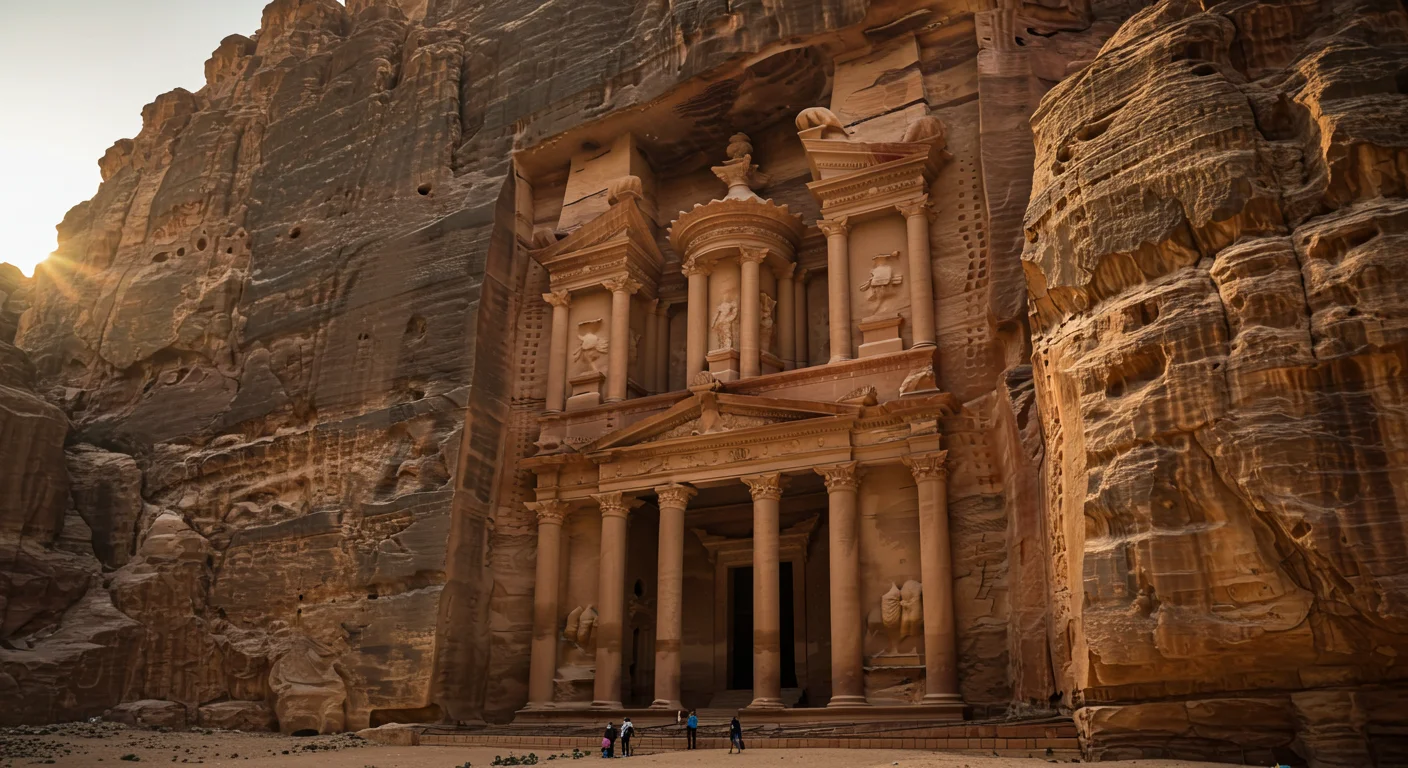The Ancient Secrets Unveiled: The History Behind Petra, Jordan’s Ancient City

Petra, often called the "Rose-Red City," is an extraordinary place that seems to be straight out of a storybook. Located in the beautiful country of Jordan, this ancient city is not just old; it's one of the oldest cities in the world, filled with incredible history and amazing sights. If you've ever wondered about The History Behind Petra: Jordan’s Ancient City, you're in for a treat. This fascinating place was once a bustling capital carved directly into towering sandstone cliffs, and its story is one of incredible cleverness, grand trade, and eventual rediscovery. Today, Petra stands proudly as one of the New Seven Wonders of the World and a UNESCO World Heritage Site, attracting visitors from every corner of the globe.
Petra's Earliest Beginnings: A Home Since Ancient Times
Believe it or not, people have lived in the Petra region for an incredibly long time – more than 10,000 years!. The very first people settled here during a time called the Early Neolithic period, which was between 8500 and 5500 BCE. This was a huge step for humankind, as people were learning to stop moving around all the time and instead started building permanent homes and farming.Archaeologists, who are like history detectives, have found three ancient villages in the northern part of Petra from this time: Bayda, Ba'ja, and Shkarat Mess’aed. These discoveries help us understand what life was like for some of the earliest settled communities on Earth, showing us how they changed from hunting and gathering to living in one place and growing their own food.Moving forward in time, evidence shows that people continued to live in the Petra region during the Bronze Age, which was from 3300 to 1200 BCE. At a spot called Um Saysaban, archaeologists found remains of rectangular houses and pottery, telling us that small communities kept living in this area.Then came the Iron Age (1200-600 BC), and a kingdom called Edom grew strong in the region, stretching from the Wadi el-Hasa in the north all the way to Aqaba in the south. The Edomites built settlements in the Petra region, using the natural water sources available. Two of their important settlements were Um al-Biyara and Ba'ja. But eventually, after a conflict with King Amaziah of Judah, the Nabataeans took control of the region. This set the stage for Petra's most famous period.The Rise of the Nabataeans: Master Traders and Architects
The most famous part of The History Behind Petra: Jordan’s Ancient City truly begins with the Nabataeans. These clever people arrived in the area and, by the 4th century BC, had made Petra their bustling capital. They chose this spot because it was perfectly located as a trade hub, right in the middle of important routes connecting Arabia, Egypt, Syria, and Phoenicia. They traded valuable goods like frankincense, myrrh, and spices, which made them very rich and powerful.Life in the desert is tough, but the Nabataeans were desert geniuses! They figured out how to survive and even thrive in this dry land by becoming masters of water technology. They built an amazing system of channels, tunnels, diversion dams, cisterns, and reservoirs to collect and save every drop of precious rainwater. This clever system not only provided water for their growing city but also protected them from dangerous flash floods that are common in the area. It's hard to imagine, but this desert city might have been home to as many as 30,000 people at its peak, all supported by this incredible water system.The Nabataeans were also incredible artists and builders. They didn't just build on the landscape; they built into it. They carved magnificent structures directly into the soft sandstone cliffs, creating intricate tombs, grand temples, and even a large theater. This unique style, blending their own traditions with influences from cultures like the Hellenistic Greeks, made their architecture truly special and beautiful. Some of their most famous creations include the impressive Royal Tombs, such as the Urn Tomb, the Palace Tomb, and the Corinthian Tomb. Their city was a blend of natural beauty and incredible human craftsmanship.Petra Under Roman Rule: A New Chapter
The Nabataean Empire flourished for centuries, but eventually, a new mighty power appeared: the Romans. In 106 AD, the Roman Emperor Trajan took over the Nabataean Kingdom, making it part of the Roman Empire and calling it the Arabian Provincia. Even though Petra was no longer an independent kingdom, it still remained a very important city in the region. It was even given grand titles like "Metropolis of Arabia" in 114 AD and "Hadriane Petra Metropolis" after Emperor Hadrian visited in 131 AD.During Roman rule, Petra continued to be a bustling trade center, especially with the creation of the Via Traiana Nova, a new road that connected cities from north to south. The Romans also left their mark on Petra's look. They brought their ideas of city planning, adding new structures like a colonnaded Roman road (a street with columns on either side), the Roman Soldier Tomb, and the Sextious Florentinus tomb. Even the famous theater in Petra, built during this time, showed a mix of Roman design with the traditional Nabataean stone carving skills. The fusion of Eastern and Hellenistic styles continued to define Petra's unique charm.The Decline of a Great City: Earthquakes and Shifting Sands
Sadly, even the greatest cities can face challenges that lead to their decline. For Petra, two main events contributed to its eventual abandonment, marking a pivotal turn in The History Behind Petra: Jordan’s Ancient City. The first was a series of powerful earthquakes. A major earthquake in 363 AD destroyed a large part of the city, causing significant damage to many buildings. Another earthquake in 551 CE further impacted the city.The second major blow came from changes in trade routes. As new ways of transporting goods emerged and sea routes became more popular, Petra's strategic location as a land-based trade hub became less important. Slowly, the flow of valuable goods and merchants through the city dwindled.These two factors combined – the devastating earthquakes and the shifting trade patterns – eventually led to Petra's downfall. By the middle of the 7th century AD, the city appears to have been largely deserted. It became "lost" to the outside world, remembered only by the local Bedouin people who lived in the area. For centuries, Petra's incredible carved structures stood silent, hidden by the surrounding canyons, waiting to be rediscovered.The Rediscovery of the "Lost City"
For hundreds of years, Petra was a secret, known only to the Bedouin tribes. It was truly a "lost city" to the Western world, its magnificent ruins hidden away. But in 1812, a curious Swiss explorer named Johannes Burckhardt decided to embark on a journey that would change The History Behind Petra: Jordan’s Ancient City forever. He had studied Arabic and prepared himself carefully, understanding that to see the rumored secret ruins, he needed to blend in.Dressed as an Arab and convincing his Bedouin guide, Burckhardt made his way to the hidden city. He couldn't stay long or start digging, as he had to be careful not to reveal his true intentions, but his brief visit was enough. He saw the incredible rock-carved structures, and his "discovery" paved the way for future explorers and archaeologists to come and study Petra. After Burckhardt's account, Petra became increasingly famous in the West as a beautiful and fascinating ancient city, and it began attracting visitors – a trend that continues to this day.It was also around this time that Petra earned its famous nickname, the "Rose-Red City". This name comes from the stunning color of the sandstone rock from which many of the city's buildings were carved. An English cleric named John William Burgon, even though he had never visited Petra, wrote a poem in 1845 that perfectly captured its essence: "Match me such marvel save in Eastern clime, a rose-red city half as old as time." This beautiful description stuck, and Petra has been known by this lovely name ever since. The color truly comes alive, especially noticeable at sunset.Architectural Wonders and Hidden Gems
Petra is much more than just a collection of old buildings; it's an entire city sculpted from stone, showcasing the deep History Behind Petra: Jordan’s Ancient City. When visitors first arrive, they usually enter through a long, narrow canyon called the Siq. This winding path, a natural rocky cleft, dramatically leads to the city's main entrance. Walking through it feels like stepping back in time.The most famous sight inside Petra, and perhaps the most iconic, is the magnificent building known as the Treasury, or Al-Khazna. Built around the 1st century CE, this spectacular structure is half carved into the cliff and stands an impressive 130 feet tall. Its facade is covered with incredibly detailed and well-preserved Hellenistic designs, topped by a large funerary urn. You might even recognize it from its appearance in the famous movie Indiana Jones and the Last Crusade. Interestingly, this urn has bullet holes because locals once believed it contained hidden gold, though it's actually solid stone.Beyond the Treasury, there are countless other wonders. There's Al-Deir, also known as "the Monastery," a massive monument reached by climbing more than 800 steps. The city also features a colonnaded street, ruins of temples, baths, and various tombs, each telling a piece of Petra's long story. Archaeologists estimate that only about 20% of Petra has been discovered so far, meaning 80% is yet to be uncovered. This is why new discoveries are still being made, like a huge, previously unknown monument found in 2016 using satellite imagery.Petra even had its own "suburb" called Little Petra, or Siq al-Barid. This smaller area likely served as a resting place for visiting traders and was close to the homes of some city merchants. Although it doesn't get much direct sunlight (which is why it's also called "Cold Canyon"), it holds hidden treasures like ancient rock-hewn dwellings, water channels, and beautiful wall paintings, such as those in the "Painted House".Petra's Enduring Legacy and Modern Recognition
Today, Petra is recognized worldwide for its incredible historical and cultural value. It was designated a UNESCO World Heritage Site in 1985, meaning it's considered so special that it needs to be protected for everyone, forever. Later, in 2007, it was also chosen as one of the New Seven Wonders of the World, cementing its place among the most amazing human achievements on Earth.This recognition, along with its appearance in famous films, has made Petra a must-see destination, and visitor numbers have grown steadily. In fact, in 2023, over 1.1 million people visited Petra. The Petra Archaeological Park, which covers a vast area of 26,171 hectares, is actively managed to protect this ancient treasure. Experts work to preserve its delicate sandstone structures from natural erosion and manage the impact of tourism, ensuring that future generations can also experience the magic of The History Behind Petra: Jordan’s Ancient City.The incredible water management systems, the vast number of tombs and temples carved into the rock, and the blend of Eastern and Hellenistic architectural styles all contribute to Petra's "Outstanding Universal Value". It's a place that tells the story of many past civilizations, from the earliest Neolithic settlements to the mighty Nabataeans, Romans, Byzantines, and even Islamic periods. The local Bedouin communities also have a deep connection to Petra, and their cultural space in Petra and Wadi Rum is recognized as intangible cultural heritage.Conclusion: A Journey Through Time in the Rose-Red City
The History Behind Petra: Jordan’s Ancient City is a captivating tale of human ingenuity, resilience, and artistry. From its humble beginnings as Neolithic villages to its glorious days as the Nabataean capital and its subsequent rediscovery, Petra has witnessed millennia of human stories. It stands as a powerful reminder of the incredible civilizations that once thrived in the desert, leaving behind a legacy of architectural marvels and advanced engineering.Walking through Petra is like stepping into a living history book, where every carved facade, every ancient water channel, and every towering cliff whispers tales of the past. It’s a place that continues to inspire awe and wonder, reminding us of the enduring power of human creation.Don't just read about this incredible history—experience it for yourself! Start planning your visit to Petra today and discover the magic of Jordan’s ancient city firsthand!



